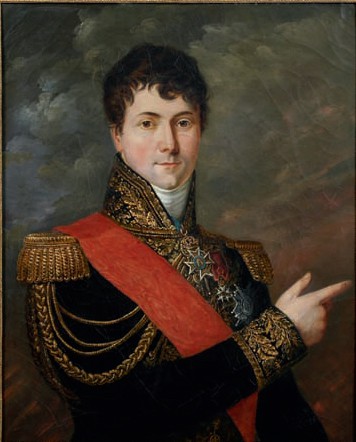From his first campaigns, he revealed himself to be as good at attack as preserving the lives of his men. He became a specialist in forceful operations, such as the Grimsel attack (1796) or the crossing of the Danube (1799). From 1804, he was often in the advance guard of the 3rd corps commanded by Marshal Davout.
Considered by his peers as a vigorous general who excelled under fire, Gudin knew how to take a blow and then go back on the attack. At Auerstedt (14 October, 1806), Gudin took advantage of the fog to engage the Prussians. He was then obliged to endure the repeated assaults of the Prussian cavalry. For 4 hours, Gudin’s infantrymen held out, allowing the rest of the 3rd Corps to get back into the line. Once his division was reorganised, he marched forward and participated in the victory. All day long, Gudin was in the thick of the fighting, leading and encouraging his soldiers. Though he received a wound during the fierce fighting, he still appeared at the head of his division when he entered Berlin.
At Wagram, the 3rd Corps’s mission was to take Neusiedel’s position to the left of the French forces. This time Gudin was not in the forefront but entered behind Morand and Friant. After a difficult crossing of the Russbach stream, Gudin scaled the plateau under a deadly fire. Sword in hand, he ensured that his division resisted the repeated assaults. After a fourth wound, Gudin was evacuated from the battlefield but not before his men had pushed back the Austrians.
Whilst Gudin was very considerate of his men, he was at the same time a demanding leader who exercised strict discipline, making sure that his soldiers were perfectly familiar with regulations and exercises.
It was in the pursuit after the battle of Smolensk on 19 August 1812, at Valoutina, that Gudin was cut down by a cannonball. Marshal Ney, in the advance guard, could not alone conquer the strong position in which a part of the Russian army was stationed. With Napoleon’s authorisation, Gudin’s division, in the wake of Ney’s corps, tried to dislodge the Russians from the plateau where they had dug themselves in. While planning the second assault, General Gudin was struck by a cannonball that took away his left leg and the calf of his right leg was “destroyed in all its thickness, right up to the bone” as Larrey noted (Mémoires de chirurgie militaire et campagnes, Paris, 2004, Vol 2, p.743). While the advantage was finally won, Gudin was taken, bleeding heavily, to Smolensk.
Segur related that “when the tidings of this misfortune reached the emperor, they put a stop to everything – to discussion and action. Everyone was thunderstruck; the victory of Valoutina seemed no longer to be a success.” (History of the Expedition to Russia undertaken by the Emperor Napoleon, in the year 1812, London: 1825, Volume 1, p. 258)
Napoleon paid him a visit the next day. As gangrene developed rapidly, it was impossible to save the general who died on 21 August. Napoleon, for whom this loss was “deeply felt”, drew a glowing portrait of the General in his 14th Bulletin: “General Gudin was one of the most distinguished officers of the army; he was estimable for his moral qualities as well as his bravery and intrepidity.” Napoleon even wrote one of rare letters of condolence to Countess Gudin in which he said: “I share in your regret; the loss is great for you; it is likewise for me too.” He also promised to look after General Gudin’s children, five orphans, who received a title and pension. Today, the descendants of the general are numerous.
During his lifetime, Gudin was much rewarded by the Emperor for his merits and military valour. He received more than 70,000 francs a year, was made Earl of the Empire, promoted to the rank of Commander of the Military Order of St. Henry of Saxony and Grand Aigle of the Légion d’Honneur. “This general was privileged to receive the affections of the Emperor”, as George Touchard-Lafosse, commissaire ordonnateur during the Empire, noted. He was also however critical of Gudin: “He was an excellent courtier at the court of the Tuileries, indeed treating his inferiors with disdainful pride. And he loved etiquette, almost to the point of childishness; he was in short an aristocrat. […] He had very many admirers but few friends.” Thiers in his History of the Empire sums up what many thought of Gudin: “This illustrious general was by his heroic courage, his perfect goodness, his cultivated mind, an object of esteem for the officers, and of popular esteem for the soldiers. His death was felt in the army as a common loss that affected everyone.”
François Houdecek
October 2019 (translation PH)


